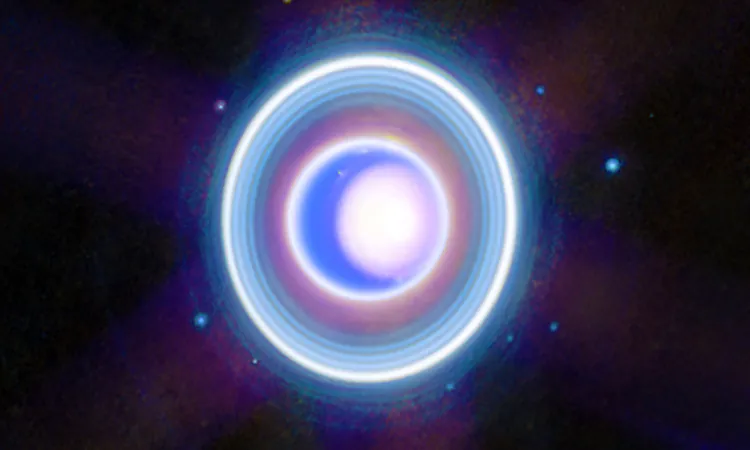
Uranus' Mysterious Moon Miranda May Harbor Ocean and Potential Signs of Life!
2024-11-04
Author: Ting
Recent research has ignited excitement in the scientific community, revealing that Miranda, one of the moons orbiting Uranus, could contain a hidden ocean beneath its icy surface. This intriguing possibility raises questions about whether this distant celestial body could support extraterrestrial life.
Uncovering water on remote moons presents significant challenges, given their vast distances from Earth. Tom Nordheim, a planetary scientist at the Johns Hopkins Applied Physics Laboratory, has taken a lead role in exploring Miranda’s potential, stating, “To find evidence of an ocean inside a small object like Miranda is incredibly surprising.” Such findings not only challenge previous beliefs about the moon but also open new avenues for understanding the potential for life beyond Earth.
A Peek into Miranda’s Unique Moonscape
Miranda’s surface is a striking geological puzzle. When Voyager 2 flew by in 1986, it captured extraordinary images of the moon, showcasing an odd landscape filled with deep grooves, sheer cliffs, and unusual trapezoidal regions called coronae. The moon's irregular features invite speculation about its geological history and the forces that shaped it.
The Enigma of Uranus
Uranus itself is a fascinating planet; it uniquely rotates on its side, resulting in extreme seasonal variations as each pole experiences 42 years of sunlight followed by 42 years of darkness. This peculiar axial tilt is believed to be a result of a colossal collision in the planet's early history. Uranus' atmosphere is rich in icy components, including water, ammonia, and methane, which contribute to its distinctive blue-green hue and are vital for potential habitability.
The Surprising Revelation of a Hidden Ocean
The research team, which included graduate student Caleb Strom and planetary scientist Alex Patthoff, approached the mystery of Miranda's potential subsurface ocean by reexamining Voyager 2 images with advanced computer modeling techniques. Their groundbreaking findings suggest that between 100 to 500 million years ago, Miranda might have had an ocean approximately 62 miles deep beneath a thin crust of ice, possibly no thicker than 19 miles.
The unexpectedness of these results has left researchers amazed. “That result was a big surprise to the team,” recognized Strom, underscoring that a moon of Miranda’s small size hosting a significant ocean is beyond prior expectations.
The Role of Gravitational Forces
Interestingly, the warmth that may have kept this ocean in a liquid state could be attributed to the effects of gravitational forces from nearby moons and Uranus itself. This interaction, known as orbital resonance, creates friction within Miranda’s interior, generating the heat necessary to sustain a subsurface ocean — a finding that defies common assumptions about distant moons' capabilities.
The Quest for Extraterrestrial Life
While it could be premature to consider a journey to Miranda in search of life, the notion of it harboring conditions suitable for life is captivating. Current evidence remains inconclusive; however, the absence of certain expected surface features suggests that Miranda may still retain a liquid ocean beneath the ice.
The research echoes the earlier discovery of active geysers on Saturn's moon Enceladus in 2004, which revealed hidden oceans and solidified its status as a prime candidate in the search for extraterrestrial life. This comparative analysis highlights the potential significance of Miranda.
Future Explorations Await!
The tantalizing possibility of life in the subsurface ocean of Miranda necessitates further investigation. According to Nordheim, “We’re squeezing the last bit of science we can from Voyager 2’s images.” To unlock the mysteries of Miranda, researchers advocate for new missions to Uranus, where fresh data may provide definitive answers.
Miranda stands as a potential underdog in our solar system’s narrative, challenging preconceptions about what we know regarding celestial bodies. The thought that this small, icy moon could conceal an expansive ocean that might foster life is nothing short of astonishing.
In the grand quest to unearth secrets in our solar system, revisiting older data with innovative insights continues to pave the way for revolutionary discoveries, possibly rewriting our understanding of life beyond Earth. Are you ready for the next giant leap into the cosmos? Keep watching as we await new missions to unveil the wonders of Uranus and its enigmatic moon, Miranda!




 Brasil (PT)
Brasil (PT)
 Canada (EN)
Canada (EN)
 Chile (ES)
Chile (ES)
 España (ES)
España (ES)
 France (FR)
France (FR)
 Hong Kong (EN)
Hong Kong (EN)
 Italia (IT)
Italia (IT)
 日本 (JA)
日本 (JA)
 Magyarország (HU)
Magyarország (HU)
 Norge (NO)
Norge (NO)
 Polska (PL)
Polska (PL)
 Schweiz (DE)
Schweiz (DE)
 Singapore (EN)
Singapore (EN)
 Sverige (SV)
Sverige (SV)
 Suomi (FI)
Suomi (FI)
 Türkiye (TR)
Türkiye (TR)